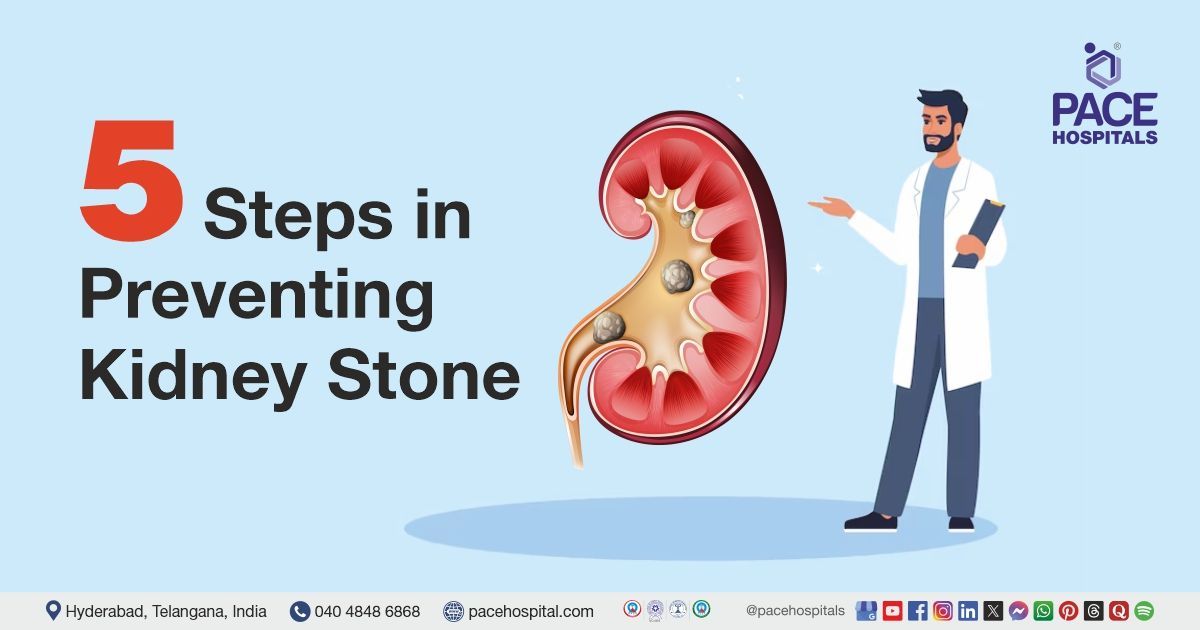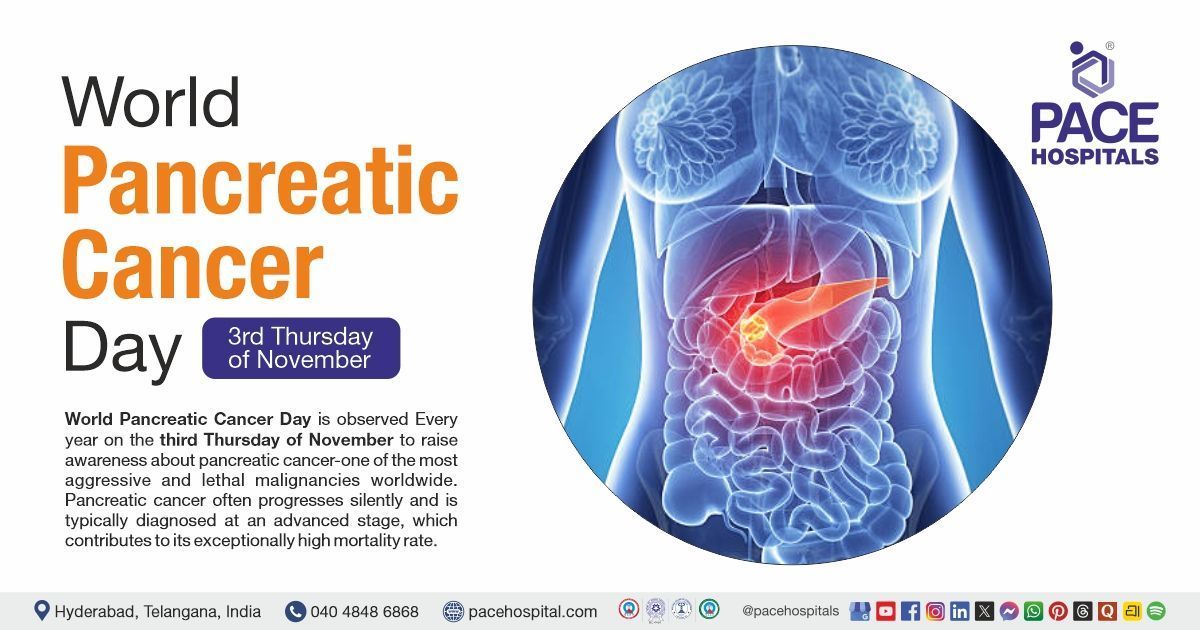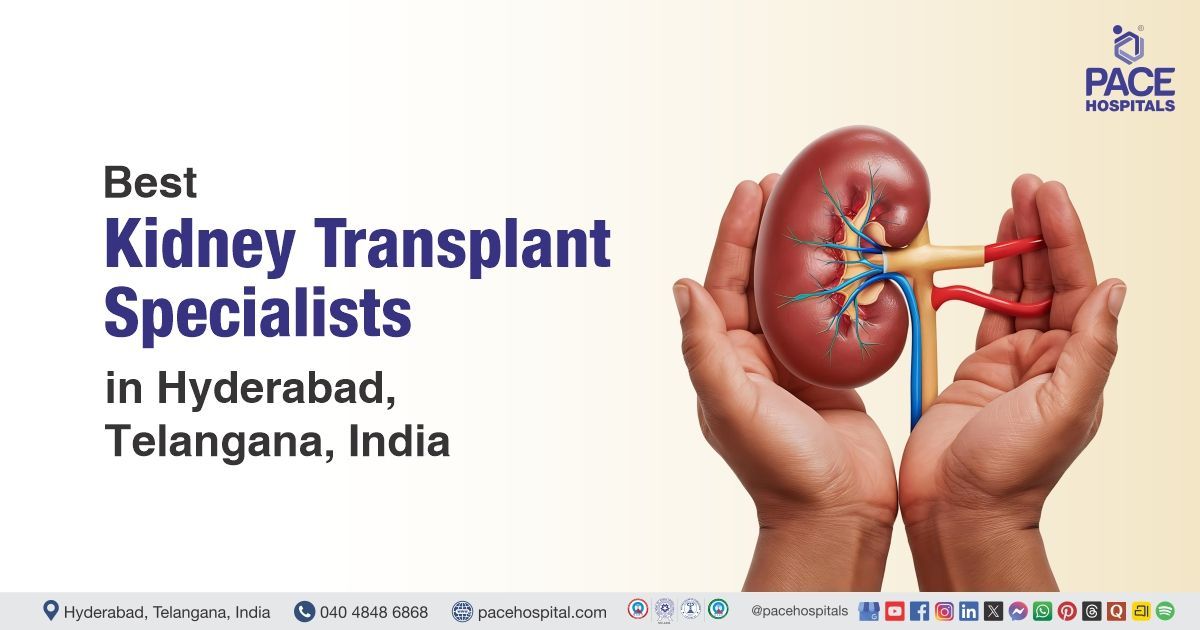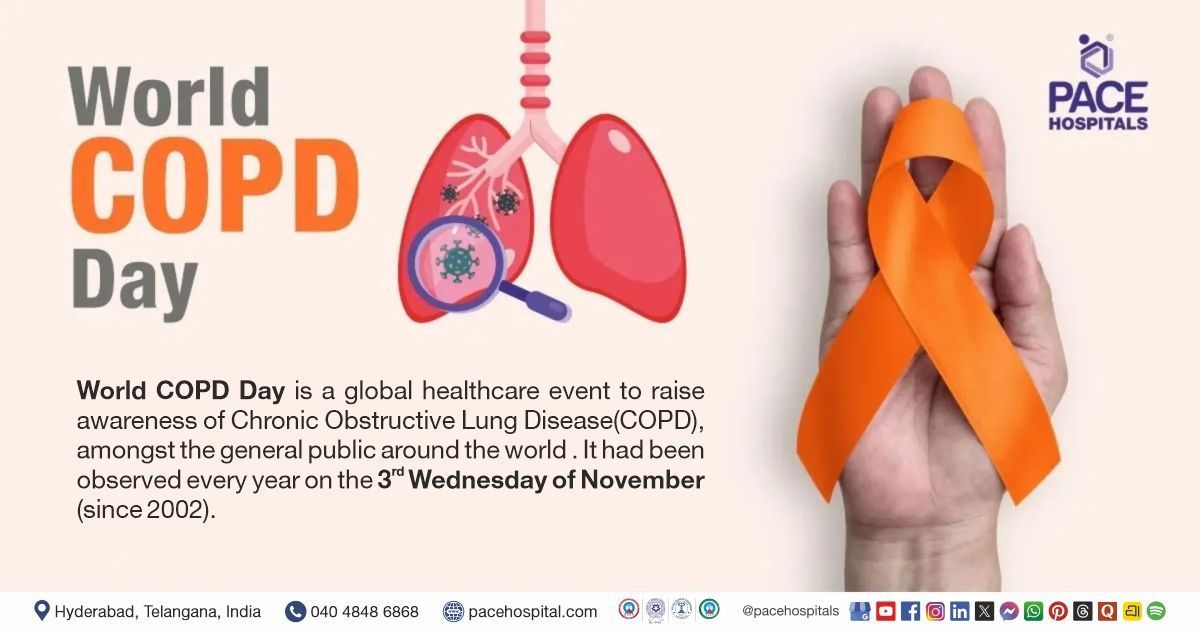Headache - Symptoms, Types, Causes, Prevention, and Treatment
PACE Hospitals
Overview | Prevalence | Types | Causes | Symptoms | Risk factors | Complications | Diagnosis | Treatment | Prevention | FAQs | When to consult a Doctor
Headache definition
A headache is defined as pain in any part of the head, including the face, scalp, and inside the head. Headaches can affect people of all ages, races, and economic status. Headaches vary considerably in intensity and the severity of the underlying medical conditions that cause them. Some headaches occur frequently (episodic) and may last for days or weeks at a time (chronic). Pain may be slight or severe, and it may be accompanied by symptoms like nausea or increased sensitivity to noise or light. The activation of pain-sensitive structures in the brain, skull, face, sinuses, and teeth causes headaches.
Without proper treatment, headaches may be severe and disturb daily activities. These complex conditions, which affect the individual in many aspects of everyday life, require a treatment plan that includes both preventive and acute therapies. Headaches can be treated effectively by general physicians or neurologists. Treatment for a headache varies by its frequency, severity, and symptoms.
Headache meaning
The term headache comes from the Old English word heafodece, which means "head" and "ache," and refers to head pain. In medical terminology, headaches are also known as cephalalgia, where "cephalo-" means head and "-algia" means pain.
Headache Prevalence
Prevalence of headaches in the world
The worldwide prevalence of headache disorders is high, with estimates indicating that roughly 52% of the population suffers from active headache disorders. Specifically, 14% suffer from migraine, 26% from tension-type headaches, and approximately 15.8% have headaches every day.
Prevalence of headaches in India
Headaches are India's most frequent neurological condition, affecting around 4.88 crore people. Among these, 2.13 crore suffer from migraines and 3.74 crore from tension-type headaches, with a significant increase in prevalence over the years, especially among women aged 35 to 59 years.

Types of Headaches
There are different types of headaches, which differ significantly according to cause, frequency, and severity. Below are the three types of headaches:
- Primary headache
- Tension-type headaches
- Migraine
- Trigeminal autonomic cephalalgias
- Other primary headache conditions
- Secondary headache
- Neuropathies, facial pain, and other headaches
Primary headache
This type of headaches occurs on their own. Primary headache types include:
- Tension-type headaches: Tension type headaches are the most prevalent type of headache. People can experience this form of headache infrequently, frequently, or chronically. Although the exact causes of tension-type headaches are uncertain, current research suggests that a person's genes, brain impulses, and muscle discomfort all play an essential role. Tension-type headaches typically cause mild to moderate pain and feel like persistent pressure on the face, head, and neck. They may also feel like a belt is tightening around the head. Most people have pain on both sides of their heads.
- Migraine: Migraine is a condition in which a person experiences repeated episodes of moderate to severe throbbing and pulsating pain on one side of the head. Migraine occurs in both children and adults, and it affects women more frequently than men. Migraine symptoms vary from person to person, although they typically include recurring headaches. They may also include nausea, vomiting, mood changes, excessive fatigue, and sensitivity to light, noise, and odors. These symptoms might occur simultaneously during a migraine episode or separately in between migraine attacks. Migraine attacks can range from hours to days, making it difficult to do daily tasks.
- Trigeminal autonomic cephalalgias (TACs): TACs are rare conditions in which pain occurs on one side of the head. Other symptoms include eyelid swelling, nose congestion, and sweating. Cluster-type headaches are the most prevalent type of TAC and the most severe primary headache. They includes sudden, severely painful episodes that frequently occur at the same time of day or night for several weeks.
- Other primary headache conditions: Other types of primary headache conditions do not exhibit the symptoms of tension-type headaches, migraines, or TACs. It might be difficult to diagnose certain types of headaches, but a doctor can diagnose them by performing tests and considering all of a person's symptoms.
Secondary headache
Secondary headaches are caused by another health condition that stimulates pain-sensitive nerve endings. Brain-related diseases cause these headaches. Various causes of secondary headaches include brain injury, brain tumors, brain stroke high blood pressure, seizures, infections, and substance misuse.
Neuropathies, facial pain, and other headaches
A third category comprises neuropathies, facial pains, and other headaches that occur as a result of nerve damage or result in head pain that are not included within the symptoms of primary or secondary headaches. Trigeminal neuralgia, a condition that affects the trigeminal nerves and is characterized by intense facial pain that occurs suddenly, is one example.
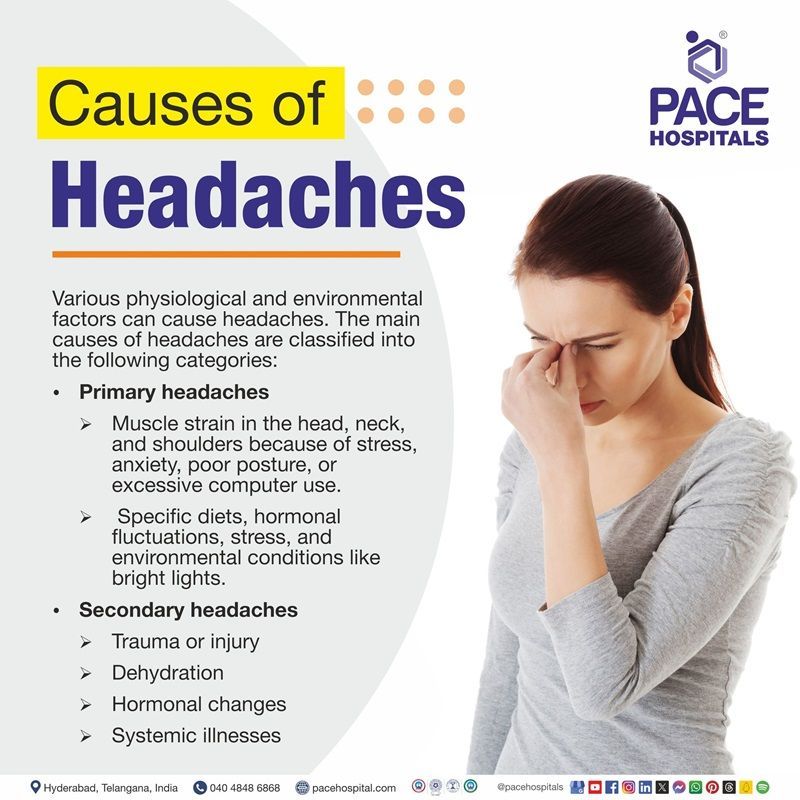
Headache Causes
Various physiological and environmental factors can cause headaches. The main causes of headaches are classified into the following categories:
Primary headaches
- Tension-type headaches: These are frequently caused by muscle strain in the head, neck, and shoulders due to of stress, anxiety, poor posture, or excessive computer use.
- Migraine: Changes in brain activity, which are frequently linked to genetic factors, trigger migraine. Specific diets, hormonal fluctuations, stress, and environmental conditions like bright lights are all common triggers.
- Cluster headaches: These headaches are caused by severe pain around one eye and can be worsened by alcohol intake or changes in sleeping patterns. The specific cause is unclear; however, it may include the hypothalamus.
Secondary headaches
- Sinus headaches: Sinus infections or inflammation can cause pressure and pain in the forehead and cheekbones.
- Trauma or injury: Head traumas can cause headaches due to inflammation or pressure changes in the brain.
- Dehydration: Insufficient water consumption can cause generalized headaches.
- Hormonal changes: Hormonal fluctuations during menstrual cycles or pregnancy may cause headaches in some women.
- Systemic illnesses: Infections (for example, the flu), high blood pressure, and other systemic conditions can cause headache symptoms.
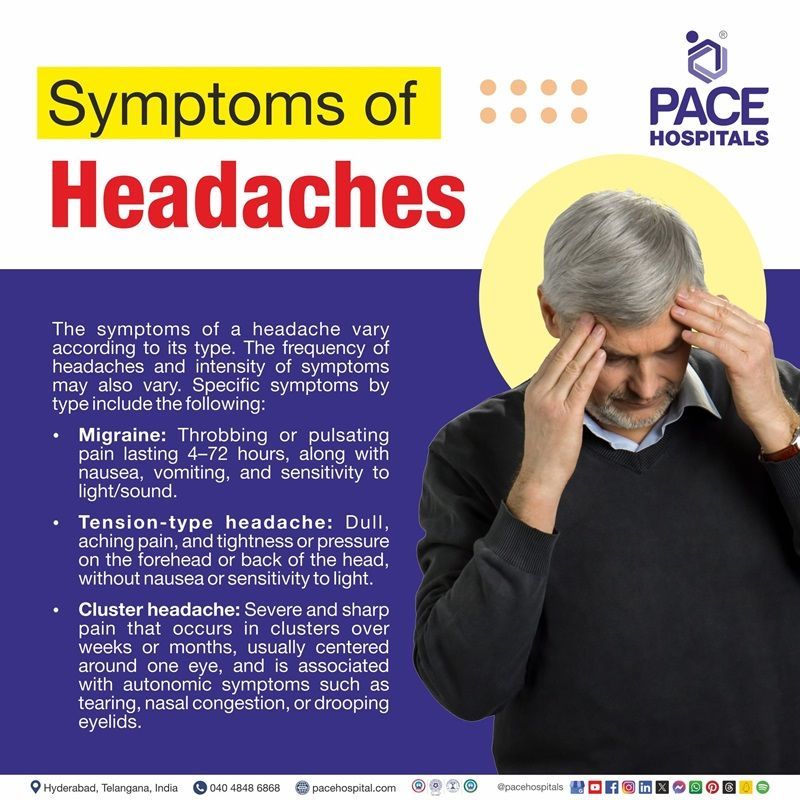
Headache Symptoms
The symptoms of a headache vary according to its type. The frequency of headaches and intensity of symptoms may also vary. Common headache symptoms include the following:
Pain characteristics
- Location: Headaches can be unilateral (one-sided) or bilateral (affecting both sides). Migraines, for example, are characterized by unilateral throbbing pain, whereas tension headaches can cause a dull, pressing sensation on both sides of the head.
- Intensity: Pain can be slight or severe and disrupt daily activities. Migraines are often considered moderate to severe and can be challenging, but tension-type headaches normally cause mild to moderate pain.
Associated symptoms
- Nausea and vomiting: These are frequently related to migraines; people may experience nausea and vomiting during a migraine.
- Sensitivity to light and sound: Phonophobia (sensitivity to sound) and photophobia (sensitivity to light) are common in people with migraines but less common in tension headaches.
- Aura: Some people have an aura before a migraine episode, which can include visual disturbances (such as flashing lights), sensory alterations, or motor symptoms.
- Fatigue and mood changes: Individuals may experience tiredness or irritability after a migraine attack. Mood changes may also occur before a headache starts.
Specific symptoms by type
- Migraine: Symptoms include throbbing or pulsating pain lasting 4–72 hours, along with nausea, vomiting, and sensitivity to light and sound.
- Tension-type headache: Symptoms include dull, aching pain and tightness or pressure on the forehead or back of the head, without nausea or sensitivity to light.
- Cluster headache: Severe and sharp pain that occurs in clusters over weeks or months, usually centered around one eye, and is associated with autonomic symptoms such as tearing, nasal congestion, or drooping eyelids.
Severe headache symptoms
- The sudden onset of a severe headache ("thunderclap headache")
- Headache along with neurological symptoms such as disorientation or weakness.
Headache Risk Factors
Several risk factors can increase the likelihood of getting headaches. Understanding them can help people identify potential triggers and manage them more effectively. Below are some of the risk factors for headaches:
- Genetics: A family history of headaches, particularly migraines, considerably increases the risk; children with parents who experience migraines have a higher probability of getting them.
- Dietary triggers: Particular foods (e.g., aged cheeses, processed meats, alcohol) and additives (such as monosodium glutamate) can cause headaches in susceptible people.
- Stress: Emotional stress and anxiety are a major triggering factors for tension type and migraine headaches.
- Sleep issues: Irregular or inadequate sleep patterns can cause headaches, and illnesses such as sleep apnea are also associated with morning headaches.
- Environmental factors: Headaches can be triggered by bright lights, strong odors, smoke, or weather changes.
- Physical activity: Heavy physical activity or bad posture during activities can result in tension type headaches.
Complications of Headache
Complications of headaches can result from both primary and secondary headache conditions. The following is a brief list of potential complications resulting from particular conditions:
Complications of primary headaches
- Medication overuse headaches: These are also known as rebound headaches. Excessive use of pain relief medications can lead to increased headache frequency and intensity, requiring a change in treatment approach.
- Status migrainosus: A severe migraine attack lasting longer than 72 hours can cause dehydration and may need hospitalization.
- Gastrointestinal issues: Long-term usage of nonsteroidal anti-inflammatory medicines (NSAIDs) for headache treatment can cause abdominal pain, ulcers, and gastrointestinal bleeding.
- Persistent aura without infarction: Aura symptoms that last more than a week can resemble stroke symptoms but do not indicate actual damage in the brain.
- Migrainous infarction: This uncommon but life-threatening complication resembles a stroke and happens when a migraine with aura leads to diminished blood supply to the brain, potentially resulting in irreversible damage.
- Neurological complications: Seizures, particularly those with aura, can occur along with migraines.
- Mental health disorders: Frequent migraine sufferers are at a greater risk for depression and anxiety, which may worsen their headache symptoms.
Complications of secondary headaches
- Visual disturbances: Secondary headaches associated with conditions like glaucoma can cause vision loss if not managed or treated immediately.
- Sleep disorders: Headaches can affect sleep habits, causing insomnia (sleeplessness) and complicating headache treatment.
- Increased intracranial pressure: Conditions that cause high pressure in the skull can cause severe headaches and neurological impairments.
- Life-threatening conditions: Secondary headaches may suggest underlying severe conditions such as brain tumors, subarachnoid hemorrhage, or meningitis and require prompt treatment.
- Chronic pain syndromes: Persistent secondary headaches may change into chronic pain issues that considerably affect quality of life and require continuing management.
- Cervical artery dissection: This condition is characterized by significant neck pain and headaches after trauma and can cause stroke-like symptoms.
Headache Diagnosis
Headaches are diagnosed using a systematic approach, which includes several important factors. Following are the steps commonly included in the diagnostic process for headaches:
- Medical and headache history
- Physical and neurological examination.
- Laboratory tests
- Blood
- Urine
- Fluid tests
- Neuroimaging tests
- CT (computed tomography) scan
- MRI (magnetic resonance imaging)
- Cerebrospinal Fluid (CSF) analysis
- Lumbar puncture (also referred to as spinal tap)
- Electroencephalogram (EEG)
Headache Treatment
Modalities of treatment differ depending on the type of headache, its frequency, and intensity. The following are the primary headache treatment options, which include:
- Non-pharmacological therapy
- Pharmacological therapy
- Nonsteroidal anti-inflammatory drugs (NSAIDs)
- Triptans
- Anticonvulsants
- Beta-blockers
- Calcium channel blockers
- Antidepressants
- Alternative therapies
- Acupuncture
- Chiropractic
- Biofeedback
- Meditation
- Relaxation training
- Cognitive-behavioural therapy
Why Choose PACE Hospitals?
Expert Super Specialist Doctors
Advanced Diagnostics & Treatment
Affordable & Transparent Care
24x7 Emergency & ICU Support
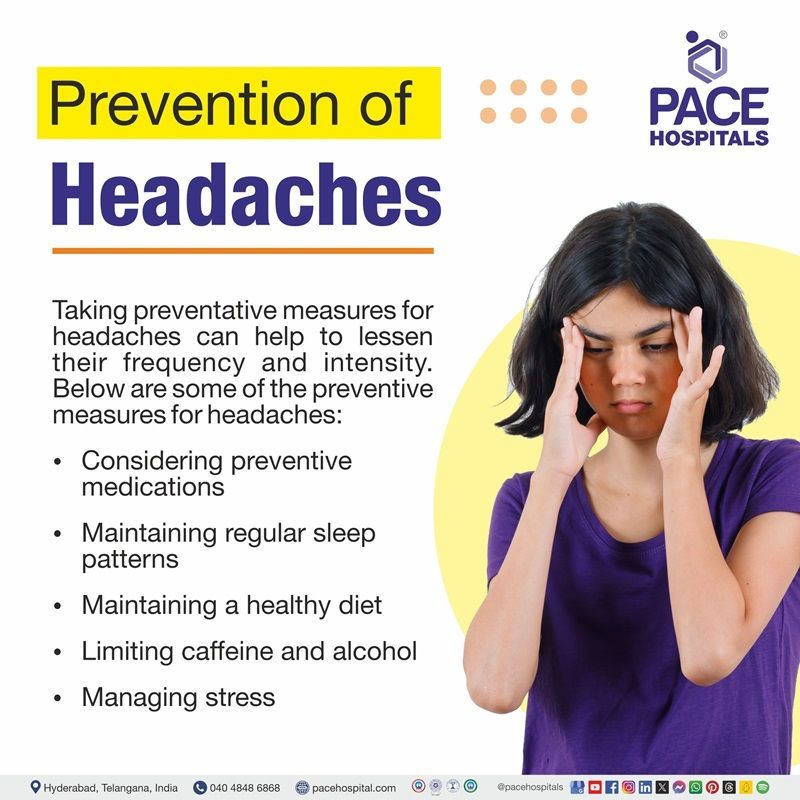
Headache Prevention
Taking preventative measures for headaches can help to lessen their frequency and intensity. Below are some of the preventive measures for headaches:
- Considering preventive medications: People experiencing frequent headaches are advised to consult a physician to enquire about preventive drugs such as beta-blockers, anticonvulsants, and antidepressants.
- Maintaining regular sleep patterns: People need to maintain consistent sleep patterns by going to bed and waking up early at the same time every day. Adequate sleep can help avoid headaches caused by tiredness or irregular sleep.
- Maintaining a healthy diet: To maintain blood sugar levels normal, people need to eat regular, well-balanced meals. Avoid missing meals and restrict the consumption of headache-inducing items like processed meats and monosodium glutamate (MSG).
- Limiting caffeine and alcohol: Limiting the consumption of coffee and alcohol, as both can cause headaches in certain people. Consuming both of these in moderation can help prevent headaches.
- Managing stress: People need to practice stress-reduction strategies, including yoga, meditation, and deep breathing exercises. Regular physical activity can help reduce stress.
Frequently Asked Questions (FAQs) on Headache
How to reduce headache?
Non-pharmacological and pharmacological techniques can be used to treat headaches effectively. Acupuncture, cognitive behavioural therapy (CBT), and biofeedback are non-pharmacological treatments that have shown efficacy in reducing headache frequency and intensity. Furthermore, pharmaceutical alternatives such as NSAIDs and triptans are indicated for short term relief, mainly in migraine and tension headaches. Combining these approaches can improve the overall treatment outcomes.
How long do migraine headaches last?
Migraines usually last a few hours to a few days and can be treated effectively. However, in some cases, the migraine is very intense and long-lasting, and it may even become chronic, recurring for weeks, months, or even years. If not managed effectively or left untreated, intermittent migraines can turn into chronic daily headaches, with constant and persistent symptoms that occasionally erupt into a "full-blown" migraine. This is a quite challenging problem to treat.
Can dehydration cause headaches?
Yes, dehydration can result in headaches. According to research, a lack of appropriate fluid consumption can cause headaches, particularly tension and migraine headaches. Symptoms usually improve rapidly after rehydration, emphasizing the necessity of staying hydrated to avoid headaches. Increased daily water intake has been found in studies to lower the frequency and intensity of headaches in those who are at risk.
When to worry about a headache?
People need to be concerned about a headache if it has "red flag" symptoms. These include the sudden onset of severe headaches (commonly referred to as a "thunderclap headache"), new headaches after the age of 50, headaches related to neurological abnormalities (such as weakness or altered consciousness), or headaches accompanied by systemic symptoms such as fever and neck stiffness. Furthermore, headaches that intensify over time or alter in pattern require prompt medical attention to rule out significant underlying diseases such as intracranial hemorrhage or tumors.
Why headache occurs?
Headaches are caused by the activation of pain-sensitive nerve endings known as nociceptors in response to various stimuli such as stress, inflammation, or blood flow changes. These nociceptors transmit pain signals via the trigeminal nerve to the brain, which processes them as headache pain. Headaches are a condition with both primary and secondary classifications, as muscle tension, vascular changes, and neurological dysfunction can all contribute to their onset.
Is headache a symptom of covid?
Yes, headache is a common
COVID-19 symptom. According to research, headaches frequently start early in the illness and might present as pressure-like or throbbing pain, affecting both sides of the head. A study indicated that around 18.6% of hospitalized COVID-19 patients had headaches during the acute phase, which can remain even after recovery, adding to long-term COVID-19 symptoms.
Is headache a symptom of pregnancy?
Yes, headaches can be a pregnancy symptom, especially during the first trimester when hormones fluctuate and blood volume increases. Many women suffer from tension-type headaches or migraines during this period, which can be exacerbated by dehydration, stress, and a lack of sleep. While most headaches during pregnancy are not dangerous, persistent or severe headaches beyond 20 weeks may suggest serious conditions such as pre-eclampsia and need to be investigated by a doctor.
Which doctor to consult for headache?
For headaches, it is recommended to consult a neurologist or headache specialist. Neurologists are trained to diagnose and treat a variety of headache disorders, including migraines and tension headaches, and many specialize in headache medicine. If the headaches are severe, frequent, or unresponsive to typical therapies, consulting a qualified headache specialist may give more specialized care and sophisticated treatment alternatives.
What is a TMJ headache?
A TMJ headache is a type of headache caused by dysfunction or abnormalities of the temporomandibular joint (TMJ) that connects the jaw and the skull. This condition can cause pain referred to the brain, which is frequently accompanied by symptoms such as jaw pain, clicking sounds, and limited jaw movement. TMJ headaches may appear like other headache types, making diagnosis difficult, and they can be triggered by teeth grinding or stress. Effective management involves addressing the underlying problem with TMJ using a variety of therapy approaches.
Can air conditioning cause headaches?
Yes, air conditioning can cause headaches because of a variety of reasons. The cold, dry air from air conditioners can cause dehydration and headaches by constricting blood vessels or triggering the trigeminal nerve. Furthermore, noise from improperly maintained units and the passage of allergens can lead to headache symptoms, often referred to as "air-conditioningitis". Regular maintenance of air conditioning systems and adequate water intake may reduce these symptoms.
How to cure cluster headache?
There are various treatment options for cluster headaches. Inhaling 100% oxygen using a mask at 7-10 liters per minute may provide relief in just fifteen minutes. Triptans and nasal sprays, are also useful in treating acute attacks. Medications like corticosteroids may be recommended as preventive strategies to lessen the frequency of episodes during cluster periods.
Can constipation cause headaches?
Yes, constipation can cause headaches. According to research, there is a connection between constipation and headache issues, with studies demonstrating that those who have headaches frequently report having constipation. This association could be due to common underlying issues, including dehydration, dietary deficits, or stress, which can exacerbate the two conditions. Treatment for constipation has been suggested to improve headache symptoms in many people, indicating an association between the two conditions.
Does neck pain cause headaches?
Yes, neck pain can result in headaches, particularly cervicogenic headaches. This form of headache arises when pain travels from the neck to the head, which is commonly caused by muscular strain, nerve irritation, or cervical spine injury. Symptoms often include constant pain, which can be localized to one side of the head and provoked by neck movement or posture. Effective management involves managing the underlying neck condition to eliminate both neck pain and headaches.
Can milk cause headaches?
Several studies have related dairy consumption to the development of headaches, particularly migraines. The connection between dairy products and headaches is complicated, comprising several substances, including tyramine and histamine, which may function as triggers.
When to Consult a Doctor for a Headache?
Headaches are regular, but persistent or unusual patterns should not be ignored. If you frequently rely on painkillers, experience new or worsening headaches, or have health conditions like high blood pressure, sinus issues, or stress-related disorders, it’s essential to get evaluated by a specialist.
Key Warning Symptoms:
- A rapid, explosive headache that reaches its most vigorous intensity in seconds.
- Headache that lasts for days or keeps returning
- Pain accompanied by nausea, vision disturbances and vomiting
- Stiff neck, fever, or sensitivity to light
- Weakness, numbness, or difficulty speaking
- Headache after a head injury
If these symptoms persist, worsen, or feel different from your usual headaches, consult a neurologist or headache specialist for proper evaluation and care.
Share on
Request an appointment
Fill in the appointment form or call us instantly to book a confirmed appointment with our super specialist at 04048486868


